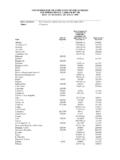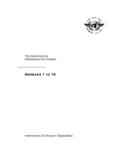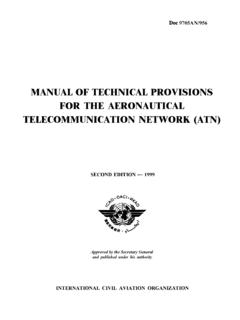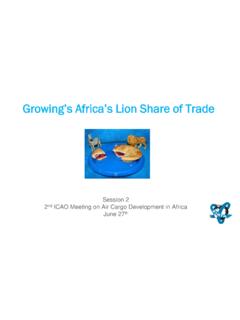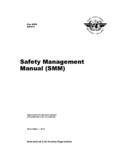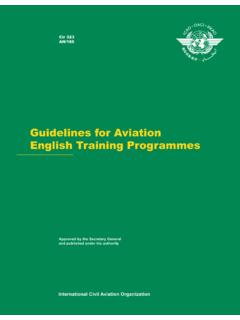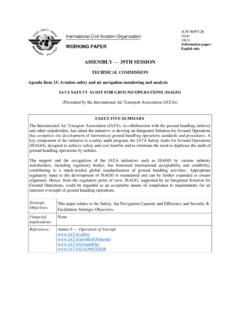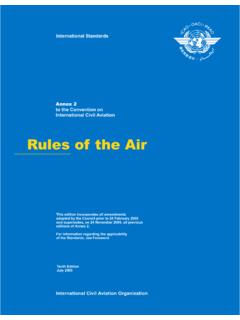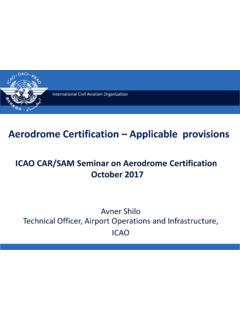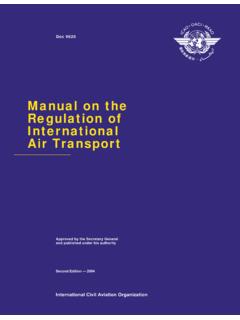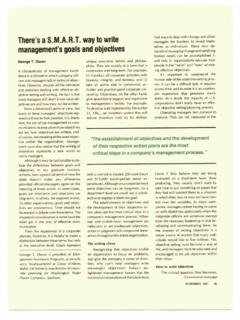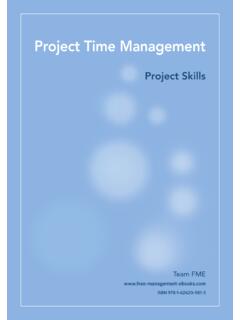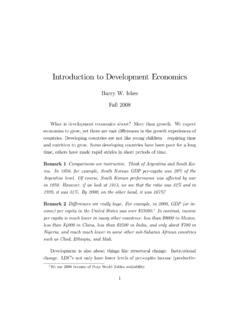Transcription of Airline Operating Costs and Productivity
1 Tehran, 20 23 February 2017 Airline Operating Costs and Productivity2 Airline Economics: Costs and Operating Costs DOT Form 41 Data Objective vs. Functional Cost Categories Percentage Break Down of Operating Operating Expense Comparisons Flight Operating Costs Example: B-757 Operating Costs Cost comparisons across aircraft Cost and Productivity Comparisons Unit Costs per ASM Aircraft and Employee Productivity31. Airline Operating Costs DOT Form 41 traffic, financial, and Operating cost data reported to the DOT by US Major airlines Data is reported and published quarterly for most tables Detail of reporting differs for different expense categories Aircraft Operating expenses by aircraft type and region of operation Other expenses more difficult to allocate by aircraft type DOT Form 41 includes the following schedules: P12 : Profit and Loss statement P52 : Aircraft Operating Expenses P6 : Operating Expenses by Objective Groupings P7 : Operating Expenses by Functional Groupings P10 : Employment Statistics B1.
2 Balance Sheet4 Objective Cost Categories Salaries and related fringe benefits General management, flight personnel, maintenance labor, aircraft & traffic handling personnel, other personnel Materials purchased Aircraft fuel & oil, maintenance materials, passenger food, other materials Services purchased Advertising & promotions, communications, insurance, outside maintenance, commissions, other services Separate categories for: Landing fees, rentals (including aircraft), depreciation (including aircraft), other expenses5 Functional Cost Categories Aircraft Operating Costs Expenses associated with flying aircraft, also referred to as Direct Operating Costs (DOC) Aircraft servicing Costs Handling aircraft on the ground, includes landing fees Traffic service Costs Processing passengers, baggage and cargo at airports Passenger service Costs Meals, flight attendants, in-flight services Reservation and Sales Costs Airline reservations and ticket offices, travel agency commissions Other Costs , including: Advertising and publicity expense General and administrative expense6 Total Airline Operating Cost Breakdown US Major Airline total Operating Costs .
3 44% is aircraft Operating expense, which includes fuel, direct maintenance, depreciation, and crew 29% is servicing expense Aircraft servicing (7%) Traffic servicing (11%) Passenger service (11%) 14% is reservations and sales expense This figure was in 1993, but declined steadily throughout the 1990s 13% is overhead expense Advertising and Publicity (2%) General and Administrative (6%)7 Functional Cost Comparison Adapted from Form 41, used by Boeing, MIT (and Aviation Daily) for more detailed comparisonsFLIGHT (DIRECT) Operating Costs (DOC) = 50% All Costs related to aircraft flying operations Include pilots, fuel, maintenance, and aircraft ownershipGROUND Operating Costs = 30% Servicing of passengers and aircraft at airport stations Includes aircraft landing fees and reservations/sales chargesSYSTEM Operating Costs = 20% Marketing, administrative and general overhead items Includes in-flight services and ground equipment ownership Percentages shown reflect historical rules of thumb.
4 8 Activity Drivers per Functional Category Aircraft Operating Costs Per Block Hour (for example, $2550 for 185-seat B757-200) Aircraft Servicing Costs Per Aircraft Departure (average $800) Traffic Servicing Costs Per Enplaned Passenger (average $15) Passenger Servicing Costs Per RPM (average $ ) Reservations and Sales Costs % of Total Revenue (average 14%) Other Indirect and System Overhead Costs % of Total Operating Expense (average 13%)9 Flight Operating Costs Flight Operating Costs (FOC) by aircraft type: Reflect an average allocation of system-wide Costs per block hour, as reported by airlines for each aircraft type Can be affected by specific Airline network or operational patterns Collected by US DOT as Form 41 Operating data from airlines Typical breakdown of FOC for US carrier:CREW: Pilot wages and benefitsFUEL: Easiest to allocate and most clearly variable costMAINTENANCE: Direct airframe and engine maintenance cost, plus burden or overhead (hangars and spare parts inventory)OWNERSHIP: Depreciation, leasing Costs and insurance10 Example: B757-200 FOC Costs per block-hour of operations (avg.)
5 186 seats):CREW$ 489 FUEL$ 548 MAINTENANCE$ 590 OWNERSHIP$ 923 TOTAL FOC$ 2550 per block-hr Based on 1252 mile average stage length and block-hr daily utilization (average for US Major): Different stage lengths and utilization by different airlines result in substantial variations in block-hour Costs for same aircraft type Also, differences in crew Costs (union contracts, seniority), maintenance Costs (wage rates), and ownership Costs (age of a/c)11 Number ofSeatsFOC perFOC perUtilizationStage LengthAirlineAircraftBlock HourSeat Hour(hrs/day)(Miles)American1011882,568$ $ ,568$ $ ,357$ $ West121902,065$ $ ,260$ $ World Air201792,656$ $ ,684$ $ ,069$ $ ,481$ $ 757 200 Flight Operating Costs12 Comparison of FOC Across Aircraft Types All else being equal, larger aircraft should have highest flight Operating cost per hour, lowest unit cost per ASM.
6 There exist some clear economies of aircraft size ( , two pilots for 100 and 400 seat aircraft, although paid at different rates) Also economies of stage length, as fixed Costs of taxi, take-off and landing are spread over longer flight distance But, many other factors distort cost comparisons: Pilots paid more for larger aircraft that fly international routes Newer technology engines are more efficient, even on small planes Reported depreciation Costs are subject to accounting procedures Aircraft utilization rates affect allocation of Costs per block-hour13A/C Type Seats FOC / block-hrFOC / seat-hr Average stage(mi)Daily block-hrsDC9-30 100 $1973 $ 472 A320 148 $2270 $ 1191 B727-200 150 $2555 $ 704 B757-200 186 $2550 $ 1252 B747-400 375 $6455 $ 4065 FOC Comparison.
7 Selected Aircraft14 FOC Comparisons (cont d) Flight Operating cost comparisons on previous slide provide insights into different aircraft characteristics: Largest B747-400 aircraft has highest total FOC per block hour, while smallest DC9-30 has highest FOC per seat hour, as expected However, lowest cost per seat hour (and in turn per ASM) provided by new technology mid-sized B757, followed by A320 B747-400 Costs suffer from high wage rates paid to senior pilots who fly international services on this aircraft type Comparisons of same-sized B727 and A320 show newer A320 with lower Costs : A320 more fuel efficient, with two pilots (vs 3 on B727) A320 has higher daily utilization, due to longer stage length15 Cost and Productivity Comparisons Average unit cost for 8 selected majors increased from to cents (4%) between 1993-1999 The top four major carriers have very similar unit Costs in this time period Unit cost increased dramatically between 1993 and 1999 for Continental (17%) and USAir (24%) Southwest and America West had the lowest unit cost, while USAir had the highest unit cost16 Unit Cost (Total System Operating Expense/ASM) Cost ($/ASM)8 Majors AverageAmericanNorthwestDeltaUnited17 Unit Cost (Total System Operating Expense/ASM) Cost ($/ASM)US Air8 Majors AverageAmerica WestContinentalSouthwest18 Aircraft Productivity Measured in ASMs generated per aircraft per day.
8 = # departures X average stage length X # seats Aircraft utilization measured in block-hours/day: Block hours begin at door close (blocks away from wheels) to door open (blocks under wheels) Gate-to-gate time, including ground taxi times Increased aircraft Productivity achieved with: More flight departures per day, either through shorter turnaround (ground) times or off-peak departure times Longer stage lengths (average stage length is positively correlated with increased aircraft utilization = block hours per day) More seats in same aircraft type (no first class seating and/or tighter seat pitch )19 AirlineFlights per DayBlock HoursStage , , ,746 Example: Boeing 737 500 Productivity20 AirlineCrewFuelMaintenanceOwnershipTotal Continental$510$430$651$698$2,291 United$927$487$1048$510$2,974 Southwest$388$537$251$350$1,526 Example: Boeing 737 500 FOC per block Hours/DayAAUADLWND aily Aircraft Utilization (block hrs/day)Top 3 Majors and $/ASMAAUADLWNUnit Aircraft Operating Cost ($/ASM)23 Measured in ASMs per employee per period As with aircraft, employee Productivity should be higher with.
9 Longer stage lengths (amount of aircraft and traffic servicing for each flight departure not proportional to stage length) Larger aircraft sizes (economies of scale in labor required per seat for each flight departure) Increased aircraft Productivity due to shorter turnaround times (more ASMs generated by aircraft contribute to positive employee Productivity measures) Yet, network airlines with long stage lengths and large aircraft have lower employee Productivity ratesEmployee Productivity24 ASMs/employee and Average Stage Length25 ASMs/employee and Average A/C Size26 Summary: Costs and Productivity Challenges Unit cost differences not entirely due to labor Costs : Differences in aircraft Productivity can account for up to one half of difference in aircraft Operating expenses per ASM Translates into about 25% of total unit cost difference between traditional carriers and LCCs Network carriers are exploring alternatives for increasing aircraft Productivity to reduce unit Costs : Continuous connecting banks to reduce ground times at hubs Higher density seating options ( removal of First Class) More point-to-point flying to increase aircraft utilization Successful new business models will depend on reducing both aircraft and labor unit Costs In addition to fine-tuning fare structures to maximize unit revenues27
